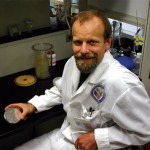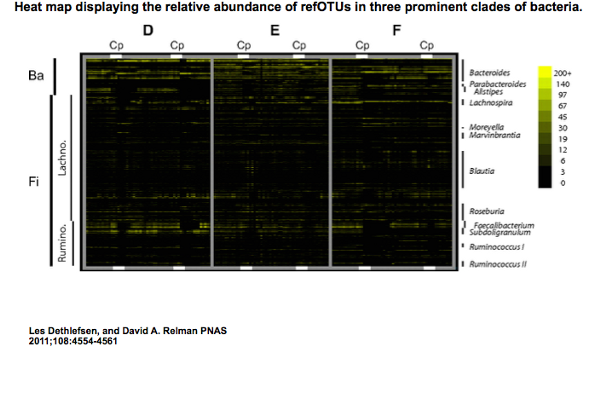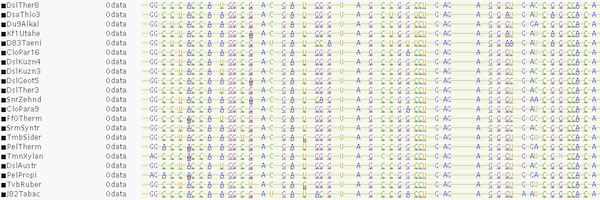What is in My Gut?
Ernesto Ramirez
March 5, 2015
This past fall we learned about a unique study, conducted at Stanford University, designed to contribute to the understanding of the human microbiome. This study also has a component not common to academic research — data is being returned to the participants. Intrigued, I contacted the principle investigator, Les Dethlefson, to learn more.
Ernesto: Tell me about the Dynamics of Human Microbiota study.
 Les Dethlefsen: Since I joined the Relman Lab at Stanford, I’ve been looking at the human gut microbiota, focusing on what affects it and how it changes over time. In our study, we are looking at three different perturbations, deliberate changes to the gut ecology, to see how the microbiota population is affected.
Les Dethlefsen: Since I joined the Relman Lab at Stanford, I’ve been looking at the human gut microbiota, focusing on what affects it and how it changes over time. In our study, we are looking at three different perturbations, deliberate changes to the gut ecology, to see how the microbiota population is affected.
We are very interested in the patterns that emerge. In people who have very stable gut microbiota, does their microbiota remain that way when they undergo diet shifts, a colon cleanout, or an antibiotic? Or maybe people who have a stable gut microbiota most of the time are the ones who are most affected by something unusual such as taking antibiotics. We just don’t know enough to understand these patterns right now. So, we’re really looking for basic ecological information.
Ernesto: If you look at the popular press, it seems the microbiome is the new golden child of biological life sciences. We’re even seeing companies in Silicon Valley get involved with this kind of work.
Les: It is broader than that. It really is a worldwide interest on the parts of both the scientific community and the public. And unfortunately, we are probably going to see some overhype, just as we did with the Human Genome Project. But I do believe this is a very important area. I think there will be a lot of payoffs and health impacts from this research, although it’s not going to be everything.
The shift that, I think, would be good for us to make intellectually is to get rid of the “us vs. them” thinking, because we are symbiotic organisms.
We have evolved with a native gut microbiota, and native microbiota is pretty much everywhere. We have evolved together, so it’s fallacious — an artifact of our past ignorance — that we don’t think of our microbes as part of our physiology.
Ernesto: It seems like exploring the deep sea, an unknown world that we’re just starting to peek into.
Les: It’s along those lines. You’re not wrong about that. But unlike, let’s say, the deep waters surrounding an undersea hydrothermal vent, we already know a lot about human physiology. There are a lot of molecular details and genetic pathways that we already have worked out. The context is somewhat understood.
And now, we have a reasonable start on the initial research: What microbes are present, and where? What’s the range of what we think is the normal distribution? We certainly don’t know enough, because we only know about people in the developed world. However, this may not represent all of human diversity or a very natural state of the gut microbiota.
Ernesto: Let’s get back to your study. You are asking participants to send microbiome data in the form of fecal matter and urine to your lab. What are you doing with those samples?
Les: We ask participants to provide both stool and urine samples. With the stool sample, we apply four different methodologies to turn it into data. One is the very common 16S ribosomal RNA (16S rRNA) gene sequencing approach. It’s relatively standard and inexpensive. It acts like an ID card for microbial taxa — telling us approximately what strains are present and in what relative abundance. We have a lot of data like that already for comparison.
The second approach we will be applying is metagenomic sequencing, wherein we will be sequencing a random selection of all the genomes of the microbial types that are present. We can’t take this to completion, even with the dropping cost of sequencing, especially because there are some very, very rare microbes that we barely even have the chance to see at all. But we can get a pretty good swathe of genetic sequence data from all the microbes.
The third approach is even more ambitious. It’s called metatranscriptomics. Genes can be carried by any critter, you and I included, but not expressed. Knowing which genes are turned on, and to what extent they’re turned on is a better measure of the biological activity that is actually happening. The metagenome is a measure of potential activities, what the bugs can do. The metatranscriptome shows what the microbes are actually doing. Metatranscriptomics is even more challenging than metagenomics partly because of the nature of messenger RNA (mRNA). It’s a highly unstable molecule. There are technical challenges, but we’re ambitious enough to try to collect information on gene expression.
The fourth approach is not based on gene sequences, but on chemical composition. Metabolomics is the name given to a number of these approaches that are not directed to a specific chemical. These are techniques that try to measure a broad swathe of chemicals present in the environment and their relative abundance. This is a technology that we, in the Relman Lab, know very little about. We’re collaborating with the Nicholson Lab in Imperial College in London, and they will be doing the metabolomic analyses on the stool samples. That may be even closer to where the rubber meets the road — knowing not just the gene expression but also the resulting chemical changes that are happening in the environment.
 Metabolomics takes us to the other type of sample we’re collecting: the urine samples. We aren’t doing this because we have an interest in the urinary microbiome itself, but because, as the Nicholson Lab suggested, the urine provides a more complete, integrated picture of the co-metabolism between the human host and most of the gut microbiota. So while metabolomics for the stool samples would primarily measure the gut microbial activity and what they contribute to the host’s physiology, the urine provides a more integrated picture about how the host metabolism works in concert with the gut microbiota.
Metabolomics takes us to the other type of sample we’re collecting: the urine samples. We aren’t doing this because we have an interest in the urinary microbiome itself, but because, as the Nicholson Lab suggested, the urine provides a more complete, integrated picture of the co-metabolism between the human host and most of the gut microbiota. So while metabolomics for the stool samples would primarily measure the gut microbial activity and what they contribute to the host’s physiology, the urine provides a more integrated picture about how the host metabolism works in concert with the gut microbiota.
Ernesto: If a participant is going to be contributing all of that data, will they have access to it?
Les: As someone with similar interests, I certainly knew that a huge motivation for people to join the study would be the access to their own data. We offer monetary compensation, but for the amount of time that will be spent in contributing samples, it is probably trivial. We knew we would attract the curious, scientifically inclined, and practising scientists. Of course, they would want to see their data.
The Institutional Review Board (IRB) was quite open to us sharing information with the participants about their own microbiota. It probably helped that there’s publicity about ways people can get this information. There is the American Gut project, offering an assessment of your microbiota for a donation, and uBiome, a private company offering the same kind of service.
I, or another staff member of the study, are going to share this microbiota data with each participant in a conference call. So in effect, I’m going to be a microbiota counselor. It’s nowhere near as high-stakes as sharing genome information. We don’t know enough to say, for example, that this microbiome is definitively healthy, or that it’s unhealthy, or what the exact risks of diseases are due to this particular composition. So we will be putting this information in context, and we will be available as interpreters of the scientific literature. We may be able to say that there is a statistical association between a particular microbial group that someone may have in their gut and some health-related outcome.
Ernesto: Will participants be getting a copy of their data as well?
Les: Yes, we will provide that. I have an open source mentality. Added to that is the fact that there are many practicing scientists signing up for the study and saying they want data, not just a PDF summary. I am happy to provide the data in as raw a format as people want. They can get the raw sequence information, a low-level summary (which is the result of the first pass of data processing), or the final summary. I have permission and full intention to share all the data derived from a person’s samples with that person.
Ernesto: Do you think we will see this happening more in the future?
Les: I think we will probably see more of it in the future. We’re moving in the direction of access to information. The open source movement has reached the health and medical realm from its origins in tech and computing. I think the participatory nature of access to data and scientific information is a good thing. It has started, and I don’t see any way of reversing the trend. I would hope that it becomes the norm that there is some appropriate level of sharing, that research participants have access to their data if they wish, and in a way that lets them interpret that data appropriately.
I believe that people have a right to that level of knowledge about their bodies, and if we, scientists, are generating that knowledge, there’s no reason not to share it with the individuals.
The Dynamics of Human Microbiota study is currenlty recruiting participants. If you’re interested in learning more about the ecosystem within read more about the study and check to see if you’re eligible to participate here.
We invite you to share your data access stories, and this article with the #qsaccess hashtag and follow along on quantifiedself.com and @quantifiedself.






